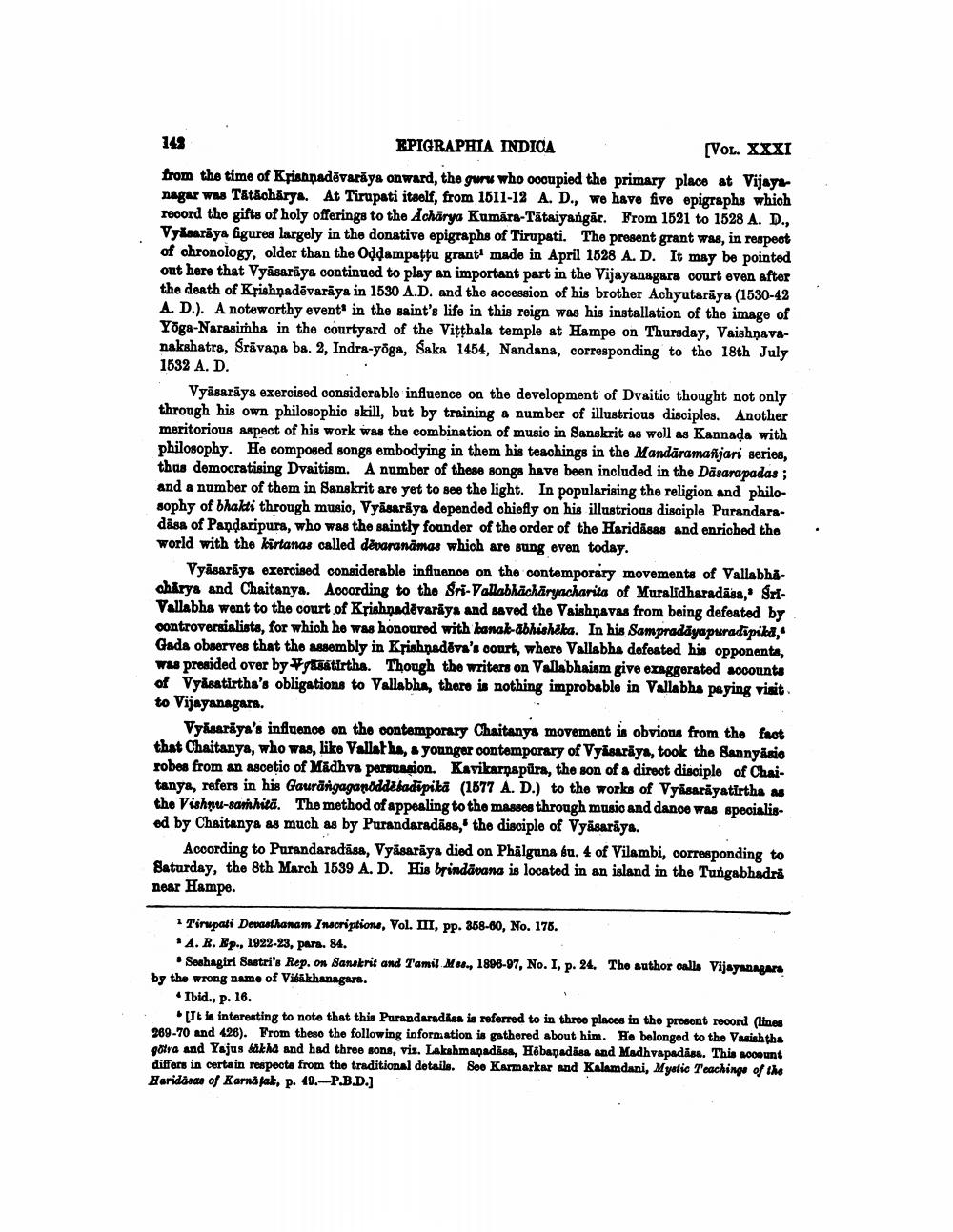________________
EPIGRAPHTA INDICA
[VOL. XXXI from the time of Krianpadēvarāya onward, the guru who oocupied the primary place at Vijay nagar was Tātãohárya. At Tirupati itself, from 1511-12 A. D., we have five epigraphs which record the gifts of holy offerings to the Acharya Kumāra-Tātaiyangār. From 1521 to 1528 A. D., Vytsariya figures largely in the donative epigraphs of Tirupati. The present grant was, in respect of chronology, older than the Oddampattu grant' made in April 1528 A. D. It may be pointed out here that Vyasaräys continued to play an important part in the Vijayanagara court even after the death of Krishnadēvariya in 1530 A.D. and the accession of his brother Achyutaraya (1530-42 A. D.). A noteworthy event in the saint's life in this reign was his installation of the image of Yoga-Narasimha in the courtyard of the Vitthala temple at Hampe on Thursday, Vaishnavanakshatra, Srāvana ba. 2, Indra-yoga, Saka 1454, Nandana, corresponding to the 18th July 1532 A. D.
Vyasarāya exercised considerable influence on the development of Dvaitic thought not only through his own philosophio skill, but by training a number of illustrious disciples. Another meritorious aspect of his work was the combination of musio in Sanskrit as well as Kannada with philosophy. He composed songs embodying in them his teachings in the Mandāramafijari series, thus democratising Dvaitism. A number of these songs have been included in the Däsarapadas; and a number of them in Sanskrit are yet to see the light. In popularising the religion and philosophy of bhakti through musio, Vysariya depended chiefly on his illustrious disciple Purandaradåsa of Pandaripura, who was the saintly founder of the order of the Haridāsas and enriched the world with the kirtanas called dēvaranāmas which are sung oven today.
Vyasarāya exercised considerable influence on the contemporary movements of Vallabhåcharya and Chaitanya. According to the Sri-Vallabhächāryacharita of Muralidharadāsa, SriVallabha went to the court of Krishnadēvarāys and saved the Vaishnavas from being defeated by controversialists, for which he was honoured with kanak-abhisheka. In his Sampradayapuradīpild, Gads observes that the assembly in Krishnadera's court, where Vallabha defeated his opponents, was presided over by Wytsatirtha. Though the writers on Vallabhaism give exaggerated accounts of Vyåsatirtha's obligations to Vallabha, there is nothing improbable in Vallabha paying visit to Vijayanagara.
Vyasarāya's influence on the contemporary Chaitanya movement is obvious from the fact that Chaitanya, who was, like Vallatha, a younger contemporary of Vyisariya, took the Sannyasio robes from an ascetic of Madhva persuasion. Kavikarnapura, the son of a direct disciple of Chaitanya, refers in his Gaurängaganoddeladipika (1877 A. D.) to the works of Vyasarāyatirtha as the Vishnu-sam hita. The method of appealing to the masses through music and dance was specialised by Chaitanya as much as by Purandaradāsa,' the disciple of Vyasarāya.
According to Purandaradāsa, Vyasarāya died on Phälguna su. 4 of Vilambi, corresponding to Saturday, the 8th March 1639 A. D. His brindāvana is located in an island in the Tungabhadra near Hampe.
* Tirupati Devasthanam Inscriptions, Vol. III, pp. 858-60, No. 176. * A. R. Ep., 1922-23, para. 84.
Seshagiri Sastri's Rep. on Sanskrit and Tamil Mas., 1896-97, No. I, p. 24. The author calls Vijayanagars by the wrong name of Vibikhanagars.
Ibid., p. 16.
It be interesting to note that this Purandaradies is referred to in three places in the present record (lines 269-70 and 426). From thero the following information is gathered about him. He belonged to the Vaish tha götra and Yajus lökha and had three sons, viz. Lakshmaṇadása, Habanadisa and Madhvapadása. This account differs in certain respecta from the traditional details. See Karmarkar and Kalamdani, Myatic Teachings of the Haridasas of Karnafak, p. 49.-P.B.D.]




